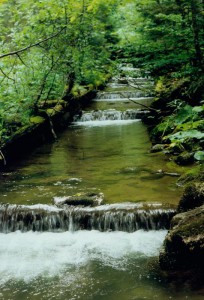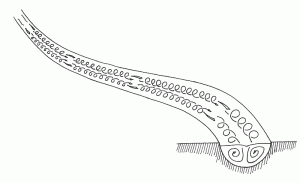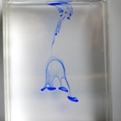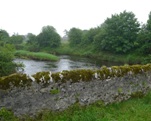
Part of the Taschlbach stream as it looks today, in the Freinbach area, Steiermark, Austria. Photo: Olof Alexandersson
“The logs will not float even 50 meters”, was the official position of the Austrian timber commission. The experts had even brought a signed written testimony to the futility of the project. It was a timber floating system, conceived by the forester Viktor Schauberger, who was presently being employed as a timber transport consultant by the Austrian Government.
The first section of the system had recently been completed in the Taschlbach stream, a wild and unruly river, not much larger than a brook.
By the side of the stream, 200 m3 of winter hewn larch and beech tree logs, each of them four to six meters tall, lay ready for transportation. In this chilly morning at the end of April 1927, the untamed brook, meandering away from the specially redesigned dam which had just been finished by Schauberger’s workers, would have to prove itself as a means for timber transport.
It was a very definite test. If failed, it would make it possible for his opponents in the forestry administration to finally get rid of the troublesome forester with his unconventional ideas.
Yet, within slightly more than half an hour, all the timber had floated all the way down to the river Mürz, four kilometres downstream, and a couple of hours later, the first logs started to arrive in Krampen-Neuberg, having travelled more than 24 kilometres. The timber commission was completely dumb-founded.
After more than two years of constant combat against the opinions of the forest engineers, Schauberger had proven his case. His opponents’ position, that his methods of timber transport and river engineering were either long known or useless, was no longer possible to uphold.”This success nobody can take from me”, he later wrote.
The battle wouldn’t end there though, but the Krampen-Neuberg timber floating system, when finished two years later, would be described as an engineering wonder in the press.
Later he would describe his methods in more detail, as well as his principles of river engineering. The idea was to use the intrinsic movements of the water. By mixing water from different layers in the dam, the released water would get the correct temperature in relation to the air and the riverbed downstream and would create the right kind of flow, keeping the timber centred at the stream.
A special arrangement at the floodgate would allow water from a chosen cross-section of the dam to be released into the stream below. This, he had realized several years ago, was the essence of the solution. To let water of the correct temperature be released from the dam, to create a flow that would spontaneously organize, self-organize we would say today, into the right flow pattern.

Axial rotation from the shores towards the centre of the river. By Morten Ovesen.
The secret was to create conditions for an axial rotation of the flow from the shores towards the centre of the stream to emerge. This would also affect sediment transport in the river, and prevent erosion damage on the shores. Yet, more than 85 years later, his methods of river engineering still sleep in obscurity. It is as if we have not grasped the lessons he demonstrated on that spring morning in 1927.
Read more
This essay gives an introduction to Viktor Schauberger’s timber transport and river engineering – a topic I have been reflecting on over the years.
Read more about the log transportation in Olof Alexandersson’s biography on Viktor Schauberger, which also contains an introduction to Schauberger’s perspective on water management:
- Olof Alexandersson Living Water: Viktor Schauberger and the Secrets of Natural Energy, Gateway, 2002. English translation from the Swedish original. Also available in a more expanded and updated German edition, as well as in French, Spanish, Czech and Greek.
The principles of regulation of rivers with the aid of temperature gradients were published by Schauberger in series of papers in Die Wasserwirtschaft in the early 1930s. English translations of most of these papers are available in Callum Coats Eco-techology series (selected writings of Viktor Schauberger). See particularly:
Viktor Schauberger, Callum Coats (Ed.) The Water Wizard: The Extraordinary Properties of Natural Water, Gateway, 1999
The following report contains a discussion on self-organization of axial flow in water from Schauberger’s perspective – with applications to e.g. river engineering:
- Johansson L., Ovesen M. & Hallberg C. Self-organizing Flow Technology – in Viktor Schauberger’s footsteps Institute of Ecological Technology, Scientific & Technical Reports, No. 1, Malmö, 2002, ISBN 91-631-2611-7 (downloadable)
Some of the ideas on timber transport and river regulation can also be glimpsed from Schauberger’s patents on timber transport. See e.g.:
- AT113526 (B) Vorrichtung zum Heranziehen und Überführen von Holzsortimenten aus Fangstauen in die Schwemmstrasse. (An overview of his timber transport system.)
- AT122144 (B) Künstliches Gerinne zum Schwemmen von Holz u. dgl. (The principle of letting different layers of water create a dragging force on the timber can be glimpsed in this patent on log flumes, although without mentioning of the temperature layers.)
- AT134543 (B) Wasserführung in Rohren und Gerinnen (The idea of creating longitudinal vortexes is discussed to some degree in this patent on water transport.)
- AT136214 (B) Anlage und Einrichtungen zur Regelung des Abflussgerinnes von Staubecken und Festigkeitserhöhung deren Abschlussdammes (Gives an idea of the practical arrangements for the use of water layers with different temperatures in dams.)
The Institute of Ecological Technology has an ongoing research programme on areas related to Viktor Schauberger:
- Institute of Ecological Technology (research overview)
More background information on Viktor Schauberger is available in the Schauberger archives of the Schauberger Family Trust:


